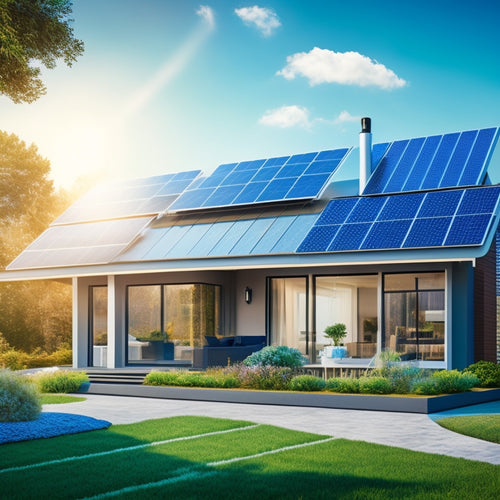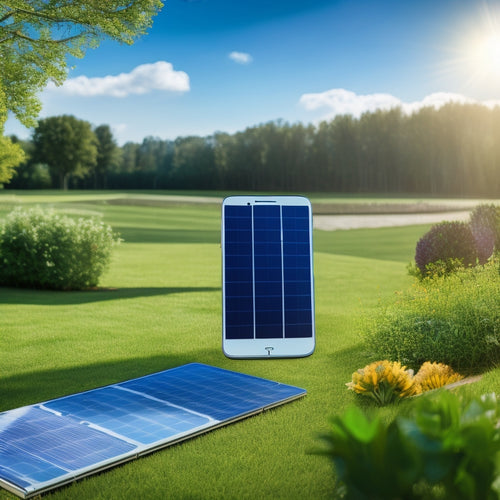
What Links HVAC Systems to Home Battery Storage?
Share
Your homes' HVAC systems and home battery storage are intimately connected through a web of energy efficiency, cost savings, and sustainability, as they work together to optimize your energy usage, reduce reliance on the grid, and minimize environmental impact. Smart thermostats integrate HVAC systems with home battery storage, automating functions to maximize energy usage based on energy storage levels. Thermal energy storage reduces energy consumption and costs, while load shifting and peak hour management allow you to utilize the full potential of your home battery storage. As you investigate the intricate dance between HVAC and home battery storage, you'll uncover even more opportunities to revolutionize your energy management strategy.
Key Takeaways
- HVAC systems can be optimized for energy efficiency, which is enhanced by home battery storage, reducing energy consumption and costs.
- Smart thermostats integrate with home battery storage to automate energy management, maximizing energy usage based on storage levels.
- Home battery storage enables HVAC load management strategies, such as shifting HVAC loads to off-peak hours, reducing energy costs and peak demand.
- Renewable energy sources like solar panels can be integrated with HVAC systems and home battery storage, enhancing energy independence and reducing carbon footprint.
- Load shifting and peak shaving capabilities of home battery storage minimize peak energy demand, reducing strain on the grid and energy bills.
HVAC System Energy Efficiency
Most HVAC systems account for nearly half of your home's energy consumption, making them a significant contributor to your utility bills. You can improve your HVAC system's energy performance by investing in system upgrades that meet the latest efficiency standards.
Regular maintenance practices, such as filter cleaning and coil maintenance, can also optimize your system's efficiency. Additionally, incorporating renewable energy solutions like solar panels or wind energy can further reduce your reliance on fossil fuels and lower your carbon footprint.
Technology advancements in HVAC systems have led to more environmentally friendly options, improving indoor air quality and reducing your environmental impact.
Thermal Energy Storage Benefits
In conjunction with energy-efficient HVAC systems, thermal energy storage (TES) solutions can greatly reduce your energy consumption and costs.
By leveraging thermal storage technologies, you can optimize your energy usage and minimize peak demand, much like how solar power reduces carbon footprint and operating costs through energy storage solutions renewable energy solutions.
This, in turn, enables you to participate in energy demand response programs, which can generate revenue and promote a more resilient grid. Additionally, TES can help reduce reliance on non-renewable sources, similar to how wind energy supports sustainable fleet operations.
- Peak shaving: Reduce peak energy demand and lower your energy bills.
- Load shifting: Shift non-essential loads to off-peak hours, reducing strain on the grid.
- Energy arbitrage: Buy energy when it's cheap and sell when it's expensive, generating revenue.
- Increased grid flexibility: Enhance the overall resilience and efficiency of the energy grid.
Smart Thermostat Integration Points
You'll want to take into account how your smart thermostat shares its data with your HVAC system and home battery storage.
By integrating your thermostat with your HVAC system, you can automate various functions, such as maximizing energy usage and adjusting temperatures based on your energy storage levels. This integration also enables advanced features, including thermostat data sharing and system automation options that can further enhance your home's energy efficiency.
Additionally, incorporating renewable energy sources, such as solar energy, can reduce grid reliance and carbon footprint, enhancing overall energy independence.
Regular maintenance, including cleaning, is essential for peak energy production and efficiency.
Thermostat Data Sharing
Through smart thermostat integration points, your HVAC system can share essential data with home battery storage systems, enabling a more harmonious and efficient relationship between the two.
This data sharing enables your home battery storage system to optimize its charging and discharging cycles based on your HVAC system's energy usage patterns, which is particularly important when considering the integration of renewable energy sources, such as solar power integration, to reduce grid reliance and carbon footprint.
By leveraging this data, homeowners can create a more sustainable and eco-friendly energy management system.
Some key benefits of thermostat data sharing include:
-
Improved energy efficiency: By analyzing your HVAC system's energy usage patterns, your home battery storage system can optimize its charging and discharging cycles to minimize energy waste.
-
Enhanced thermostat security: With data sharing, you can ascertain that your thermostat's security settings are aligned with your home battery storage system's security protocols, protecting your home from potential cyber threats.
-
Better data privacy: You can control how your thermostat data is shared and used, ascertaining that your personal preferences and energy usage habits remain private.
- Increased system reliability: By sharing data, your HVAC system and home battery storage system can work together to ascertain a reliable and efficient energy supply.
System Automation Options
One key aspect of smart thermostat integration points is the ability to automate various system functions, allowing homeowners to create a seamless and efficient energy management system.
As you investigate system automation options, you'll find that automation trends are shifting towards smart home technology advancements that prioritize energy monitoring and climate control.
By integrating your HVAC system with home battery storage, you can optimize user preferences and reduce integration challenges. This seamless connection enables you to make data-driven decisions, balancing cost implications with sustainability goals, similar to how Renewable Energy Sources are used to power EV charging stations.
Additionally, it's crucial to reflect on the role of Sustainable Charging Solutions in reducing energy waste and carbon emissions.
With system upgrades, you can access the full potential of your energy management system, enjoying increased freedom and control over your energy usage.
Load Shifting and Peak Hours
You've likely heard of Time of Use (TOU) rates, which charge you more for energy during peak hours and less during off-peak hours.
By load shifting, you can take advantage of these rate structures, shifting your energy usage to off-peak hours to reduce your energy cost savings.
With a home battery storage system, you can charge your battery during off-peak hours and use that energy during peak hours, minimizing your energy costs.
Time of Use Rates
Time of Use (TOU) rates, a pricing structure employed by utilities, charge customers based on the time of day they consume electricity. This means you pay more for energy during peak hours (when demand is high) and less during off-peak hours (when demand is low).
TOU rates are designed to encourage you to shift your energy usage to off-peak hours, reducing strain on the grid and promoting a more efficient energy system.
Here are some key aspects of TOU rates to evaluate:
-
Rate variation: TOU rates change throughout the day, reflecting the fluctuating demand on the grid.
-
Demand response: By adjusting your energy usage in response to TOU rates, you can help balance the grid and reduce peak demand.
-
Pricing incentives: TOU rates provide a financial incentive for you to adjust your usage patterns, promoting more efficient energy use.
- Seasonal impacts: TOU rates may vary by season, reflecting changes in energy demand and supply.
Energy Cost Savings
As utilities implement Time of Use (TOU) rates, homeowners can capitalize on energy cost savings by strategically shifting their energy usage to off-peak hours. By doing so, you can reduce your energy bills and achieve greater energy independence.
Load shifting with home battery storage allows you to store excess energy generated during off-peak hours and use it during peak hours, reducing your reliance on the grid. This not only leads to cost reduction but also increases the battery lifespan by minimizing deep discharge cycles.
When selecting a home battery storage system, consider system compatibility, seasonal performance, and installation considerations to optimize your energy savings. Additionally, look for financial incentives, such as tax credits, and consider the environmental impact and maintenance requirements of your system.
Off-Peak Charging
Taking control of your energy usage through off-peak charging can considerably reduce your energy bills. When you charge your home battery during off-peak hours, you're taking advantage of lower electricity rates. This strategy, also known as load shifting, allows you to store energy when demand is low and use it during peak hours when rates are higher.
Here are some benefits of off-peak charging:
-
Reduced energy costs: By charging your battery when rates are low, you'll pay less for your energy overall.
-
Increased battery capacity: Off-peak charging helps maximize your battery's capacity, ensuring you have enough power when you need it.
-
Demand response: By shifting your energy usage to off-peak hours, you're helping to reduce strain on the grid during peak hours.
- Increased energy independence: With a fully charged battery, you're less reliant on the grid during peak hours, giving you more control over your energy usage.
Home Battery System Optimization
How efficiently can your home battery system meet your energy needs when the grid goes down or during peak usage hours? To maximize your system's potential, optimization is essential.
This involves ensuring system compatibility, following installation best practices, and scheduling regular maintenance. Energy monitoring helps you track your usage and identify areas for improvement.
A well-optimized system can extend your battery lifespan, reduce your climate impact, and provide reliable grid independence. Safety considerations, such as proper ventilation and surge protection, are also vital.
HVAC Load Management Strategies
Your HVAC system is a significant energy hog, consuming up to half of your home's total energy expenditure. To optimize its performance and integrate it with your home battery storage, you need effective HVAC load management strategies.
These strategies enable your HVAC system to respond to changes in the grid, ensuring grid stability and energy resilience.
Here are some strategies you can implement:
-
Time-of-Use (TOU) optimization: shift HVAC usage to off-peak hours to reduce strain on the grid and lower energy costs.
-
Demand response programs: allow your HVAC system to adjust energy consumption in response to grid signals, promoting grid stability.
-
Load shifting: use your battery storage to power your HVAC system during power outages, maintaining climate control and indoor air quality.
- Smart technology integration: optimize HVAC performance and extend battery lifespan through advanced technology integration.
Renewable Energy Source Synergy
As you integrate your HVAC system with home battery storage, you can further enhance energy resilience by leveraging renewable energy source collaboration.
By combining your HVAC system with solar panel integration, you can optimize energy harvesting and reduce reliance on the grid. This collaboration enables you to store excess energy generated during the day for use during peak hours or at night, ensuring a steady supply of power.
This integration paves the way for energy independence, allowing you to make the most of your renewable energy sources. You can enjoy reduced energy costs, increased energy security, and a lower carbon footprint.
Frequently Asked Questions
Can HVAC Systems Operate Independently of the Home Battery Storage System?
You can design your HVAC system to operate independently of the home battery storage, ensuring HVAC autonomy and energy reliability, allowing you to control your temperature and comfort levels without relying on the battery backup.
How Do HVAC Systems Prioritize Energy Usage With Battery Storage?
When you integrate your HVAC system with home battery storage, you'll prioritize energy usage by optimizing energy efficiency through load management, ensuring your system allocates power wisely, and you'll enjoy greater control over your energy freedom.
Are There Specific HVAC System Types Optimized for Home Battery Storage?
"Absence of planning is planning to fail," so you'll want to know that specific HVAC system types, like ductless mini-splits and heat pumps, are optimized for home battery storage due to their energy efficiency and seamless system compatibility.
Can Home Battery Storage Be Used for HVAC System Backup Power?
You can utilize home battery storage for HVAC system backup power, but consider battery lifespan considerations and optimize energy efficiency benefits by selecting the right system type, ensuring seamless integration and maximum freedom from grid reliance.
Do HVAC Systems Need Modification to Integrate With Home Battery Storage?
As you consider integrating home battery storage, think of it like adding a new instrument to an orchestra - it requires harmony. You'll need to modify your HVAC system, ensuring seamless battery integration, to create a concert of efficient energy management.
Related Posts
-

What Tax Deductions Apply to Sustainable Building Materials?
You can claim various tax deductions for sustainable building materials, thanks to over 40 federal tax incentives sup...
-

7 Best Cool Roof Rebates for Energy-Savvy Homeowners
You're an energy-savvy homeowner looking to install a cool roof, and you're wondering which rebates can help you save...
-

7 Best Solar Panel Upkeep Apps for Homeowners
You can optimize your solar panel's energy output and efficiency by up to 20% with regular maintenance, which is wher...


